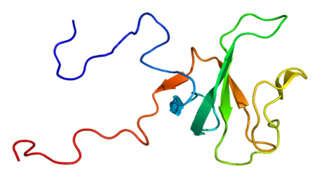Inhibitor of growth protein 4 is a protein that in humans is encoded by the ING4 gene. [5] [6]
Inhibitor of growth protein 4 is a protein that in humans is encoded by the ING4 gene. [5] [6]
The protein encoded by this gene is similar to ING1, a tumor suppressor protein that can interact with TP53, inhibit cell growth, and induce apoptosis. This protein contains a PHD-finger, which is a common motif in proteins involved in chromatin remodeling. This protein can bind TP53 and EP300/p300, a component of the histone acetyl transferase complex, suggesting its involvement in the TP53-dependent regulatory pathway. Alternatively spliced transcript variants have been observed, but the biological validity of them has not been determined. [6]
ING4 has been shown to interact with EP300, [5] RELA [7] and P53. [5] [8]

Tumor protein P53, also known as p53, cellular tumor antigen p53, the Guardian of the Genome, phosphoprotein p53, tumor suppressor p53, antigen NY-CO-13, or transformation-related protein 53 (TRP53), is any isoform of a protein encoded by homologous genes in various organisms, such as TP53 (humans) and Trp53 (mice). This homolog is crucial in vertebrates, where it prevents cancer formation. As such, p53 has been described as "the guardian of the genome" because of its role in conserving stability by preventing genome mutation. Hence TP53 is classified as a tumor suppressor gene.

Phosphatase and tensin homolog (PTEN) is a phosphatase in humans and is encoded by the PTEN gene. Mutations of this gene are a step in the development of many cancers, specifically glioblastoma, lung cancer, breast cancer, and prostate cancer. Genes corresponding to PTEN (orthologs) have been identified in most mammals for which complete genome data are available.

Netrin receptor DCC, also known as DCC, or colorectal cancer suppressor is a protein which in humans is encoded by the DCC gene. DCC has long been implicated in colorectal cancer and its previous name was Deleted in colorectal carcinoma. Netrin receptor DCC is a single transmembrane receptor.

Tuberous Sclerosis Complex 2 (TSC2), also known as Tuberin, is a protein that in humans is encoded by the TSC2 gene.

Transcription factor E2F4 is a protein that in humans is encoded by the E2F4 gene.

Metastasis-associated protein MTA1 is a protein that in humans is encoded by the MTA1 gene. MTA1 is the founding member of the MTA family of genes. MTA1 is primarily localized in the nucleus but also found to be distributed in the extra-nuclear compartments. MTA1 is a component of several chromatin remodeling complexes including the nucleosome remodeling and deacetylation complex (NuRD). MTA1 regulates gene expression by functioning as a coregulator to integrate DNA-interacting factors to gene activity. MTA1 participates in physiological functions in the normal and cancer cells. MTA1 is one of the most upregulated proteins in human cancer and associates with cancer progression, aggressive phenotypes, and poor prognosis of cancer patients.

DNA-binding protein inhibitor ID-1 is a protein that in humans is encoded by the ID1 gene.

Inhibitor of growth protein 1 is a protein that in humans is encoded by the ING1 gene.

The CYLD lysine 63 deubiquitinase gene, also termed the CYLD gene, CYLD is an evolutionary ancient gene found to be present as far back on the evolutionary scale as in sponges. In humans, this gene is located in band 12.1 on the long arm of chromosome 16 and is known to code multiple proteins through the process of alternative splicing.

Forkhead box protein O4 is a protein that in humans is encoded by the FOXO4 gene.

Suppressor of tumorigenicity protein 7 is a protein that in humans is encoded by the ST7 gene. ST7 orthologs have been identified in all mammals for which complete genome data are available.

Large tumor suppressor kinase 1 (LATS1) is an enzyme that in humans is encoded by the LATS1 gene.

Inhibitor of growth protein 2 is a protein that in humans is encoded by the ING2 gene.

JADE1 is a protein that in humans is encoded by the JADE1 gene.

Single-stranded DNA-binding protein 2 is a protein that in humans is encoded by the SSBP2 gene.
Tuberous sclerosis proteins 1 and 2, also known as TSC1 (hamartin) and TSC2 (tuberin), form a protein-complex. The encoding two genes are TSC1 and TSC2. The complex is known as a tumor suppressor. Mutations in these genes can cause tuberous sclerosis complex. Depending on the grade of the disease, intellectual disability, epilepsy and tumors of the skin, retina, heart, kidney and the central nervous system can be symptoms.

In molecular biology, mir-145 microRNA is a short RNA molecule that in humans is encoded by the MIR145 gene. MicroRNAs function to regulate the expression levels of other genes by several mechanisms.

GTP-binding protein Di-Ras3 (DIRAS3) also known as aplysia ras homology member I (ARHI) is a protein that in humans is encoded by the DIRAS3 gene.

Patched 2 is a protein that in humans is encoded by the PTCH2 gene.

Ring finger protein 43 is a protein that in humans is encoded by the RNF43 gene.
This article incorporates text from the United States National Library of Medicine, which is in the public domain.